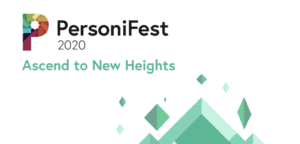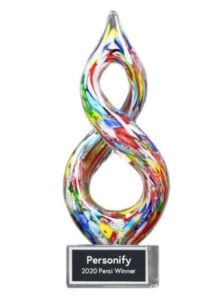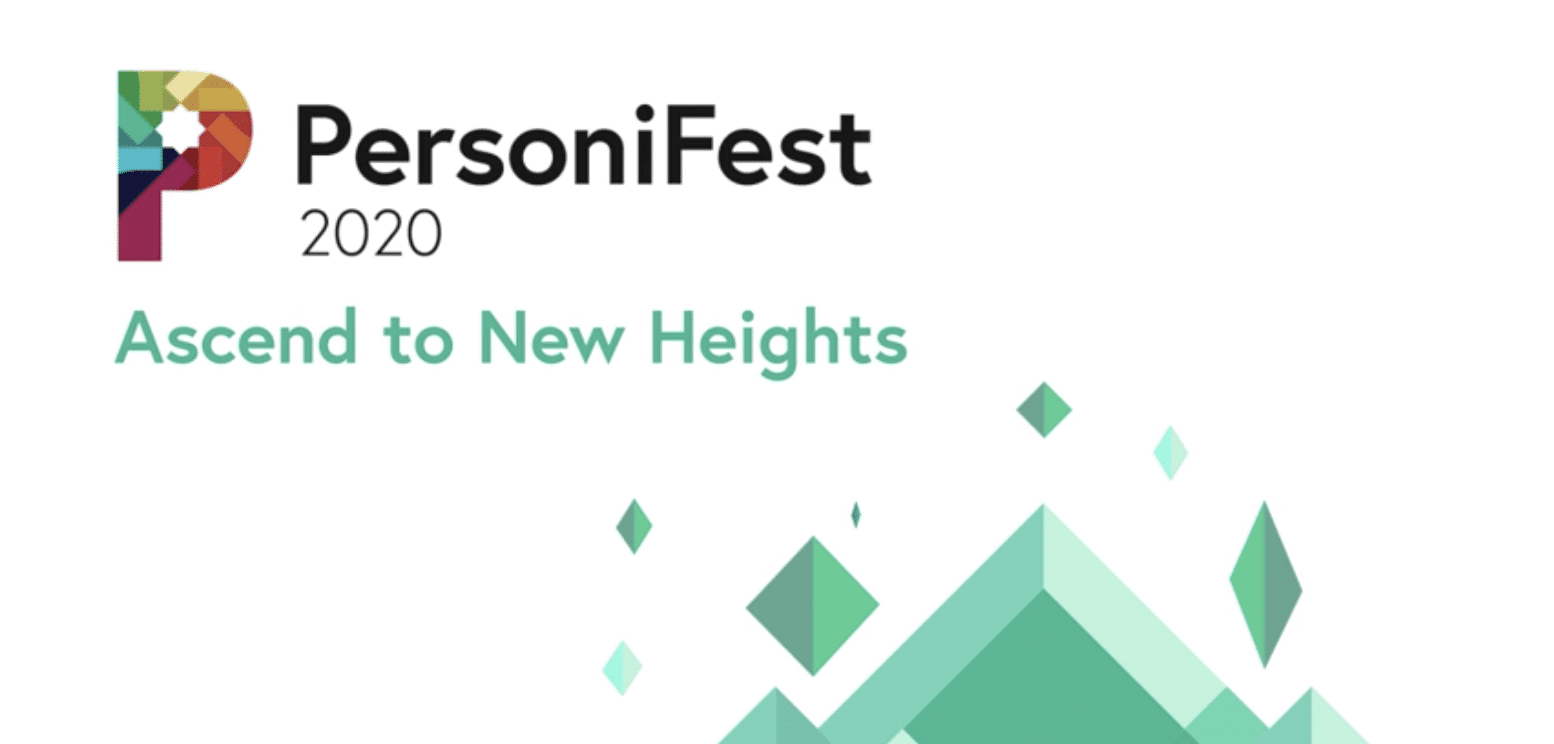How many times have you heard the term “virtual conference” in the past few weeks? If you’re like me, it’s a lot. And, at the same time, when I talk with colleagues and friends about executing virtual events, I hear questions like “but how did you actually do it” and “what tools did you use to be successful?”
 Our team recently hosted the 21st annual PersoniFest, our annual user conference for clients, partners and staff. While this conference is typically held in April and takes place in a different city each year, we made the decision to shift to a virtual event in early March due to the COVID-19 pandemic. While the planning process takes around nine months on average for the in-person event, we needed to rapidly transition to virtual in a little over a month.
Our team recently hosted the 21st annual PersoniFest, our annual user conference for clients, partners and staff. While this conference is typically held in April and takes place in a different city each year, we made the decision to shift to a virtual event in early March due to the COVID-19 pandemic. While the planning process takes around nine months on average for the in-person event, we needed to rapidly transition to virtual in a little over a month.
Today, I’m sharing a behind-the-event look at how we took PersoniFest virtual. We also chronicled this process each week leading up to the big event on Personify’s Planet Leadership podcast. I encourage you to check out the episodes.
#1 Set Realistic Goals
The first thing that we did when deciding to go virtual was to sit down with the full marketing team and rearchitect our goals and expectations for the event. Some of the key performance indicators (KPIs) that we set for the in-person conference were no longer relevant in the new setting.
It was crucial to understand what success would look like with our virtual event and use those goals to guide our approach to programming, attendance, pricing, sponsors and more. The questions that we asked included:
- What are the goals with this event and how do they differ from an in-person event?
- Can we achieve these goals in a virtual setting? The answer might be no and that’s okay.
- How does our audience change in a virtual setting? Are there accessibility issues we need to keep in mind for segments of our audience?
- Who should be involved in the planning process?
- What’s the communication strategy for sharing updates?
While a virtual event presents different challenges from a live conference, it also created new opportunities for our team. With a virtual event, our attendees do not need to book flights and hotels and be away from the office for multiple days. I am excited to share that our attendance at PersoniFest virtual was more than 5X the attendance of our previous in-person events. As a result, our team is considering how to incorporate a virtual offering into future events, even when business travel has resumed. The huge attendance numbers showed us that our clients are hungry for resources on how to better leverage the Personify products and educational content that helps them grow in their professions.
#2 Identify Your Tech Stack
After establishing our goals and expectations for the virtual event, our team quickly began evaluating our technology stack to ensure that we had the tools available to execute our plan. Each year, we want to deliver an exceptional experience for our attendees but we also want to be able to track all of the conference data back to our central database to understand the most popular topics, identify gaps in our content and inform our future R&D efforts.
We have a strategy of “build, buy and partner” with our marketing tech stack. First, we looked at the technology that was already in place for the in-person event and identified what we could repurpose in a virtual setting. We used our own A2Z Events solution to power the agenda and online booth presence for sponsors. There were some new solutions that we would need to explore. One of them was the day-of experience, so we chose webcastcloud to run the virtual conference for us. They have live-streamed the general sessions at previous PersoniFest events so it was a natural extension as we reimagined the delivery channel for our virtual sessions.
 We also partnered with Gather Voices to enable our sponsors and award winners to record videos that were available on the day of the conference. We leveraged our client communities that are powered by Personify Community to host roundtable discussions and happy hour events at the end of the day. And, we recorded the keynotes and breakout sessions using Zoom leading up to the conference and on the day of the event.
We also partnered with Gather Voices to enable our sponsors and award winners to record videos that were available on the day of the conference. We leveraged our client communities that are powered by Personify Community to host roundtable discussions and happy hour events at the end of the day. And, we recorded the keynotes and breakout sessions using Zoom leading up to the conference and on the day of the event.
There are a wealth of different platforms and tools that an organization can use to build their virtual conference. An important thing to keep in mind is to think about the user experience and actions that an attendee will need to take to navigate between the platforms. The more seamless you can make it, the better your attendee experience will be.
#3 Build Your Virtual Conference Program
We developed our approach, built out our technology stack and then turned our attention to programming for the virtual conference. It was definitely a challenge to take three days’ worth of educational content and repackage it into a one-day virtual event. We knew that in addition to attending PersoniFest, our clients are doing their day jobs remotely while homeschooling kids, sharing their make-shift home office with spouses, and trying to find the necessities like toilet paper – all while maintaining their sanity as well. There are only so many hours in the day, so it wasn’t feasible to recreate every session that was planned for the in-person event.
First, it was important to consider what kind of content our audience will have an appetite for in this new environment, then start to evaluate which of the sessions could be effectively recreated and consumed in a virtual environment.
We set up meetings with key stakeholders for each of our client verticals- people who work most closely with our clients and have the best understanding of their needs and priorities- to understand which educational sessions were crucial to include and which ones may not be the right fit for a virtual environment. We also checked in with internal and external speakers to understand how their bandwidth may have changed in recent weeks and gauge their willingness to participate.
These conversations were also opportunities to discuss ways to adjust the programming to include ideas and helpful tips to navigate this changing market and better support our attendees as they are making a similar shift for a lot of their events. So, we actually ended up adding several new sessions to the virtual program that weren’t originally included in the in-person program.
This is the approach that worked best for us, but there’s no one “right way” to do it. It depends on your audience, the types of content, the timing of your event, technology limitations, and more.
#4 Find Opportunities for Sponsors
While we made the decision to refund our sponsors upfront, we were unsure of the best way to involve sponsors in a virtual format or if we should involve them at all. We receive feedback every year that the sponsors love to meet with people face-to-face and to really become part of the Personify ecosystem. So, we didn’t want to shortchange our sponsors because we couldn’t provide that in-person experience. Yet, many of our sponsors reached out to us about joining the virtual experience. Our team then sat down and thought through a few options to provide visibility and engagement opportunities for sponsors throughout the virtual event.
We created two new virtual sponsor categories and offered them up to our list of original sponsors. While the virtual sponsor opportunities are paid, we charged a lower rate than we did for the in-person event in consideration of tight budgets during the global pandemic. We were thrilled that more half of our confirmed sponsors for the in-person event decided to join us virtually!
To make it a compelling experience, we offered online booth profiles for each sponsor with the ability to upload videos, brochures, press releases and more. We also encouraged sponsors to record a video about themselves for attendees to watch on the day of the event. We saw the highest engagement among sponsors who also presented breakout sessions, which is a similar trend for our in-person events. To create continued engagement, we offered sponsors the ability to author blog posts on the Personify blog and/or send a dedicated email to attendees of the conference.
#5 Adding the WOW factor to a Virtual Conference
One of the most important considerations for our virtual conference was the ability to engage people and get them excited without face-to-face interactions. I personally find it difficult to resist the urge to multitask and check emails while attending a virtual event, so I expected this to be a challenge for our attendees as well.
We wanted our attendees to experience glimpses of how we had originally conceived PersoniFest over the past nine months. We had a brainstorming virtual happy hour session one late afternoon where we just let our creativity run wild. This included questions such as: Should we do a virtual 5k? Should we build in bathroom breaks? Should we do celebrity cameos? Do we have a track dedicated to yoga and meditation? Basically, how do we keep people engaged on the platform and in the event when there’s so much pulling at their time?
 There were so many great ideas that came out of that brainstorming happy hour that we decided to replicate this for our attendees. So, we set up Happy Hour Roundtables that were hosted in each of the product line communities and included a variety of topics. Indeed, it was one of my favorite parts of the day to grab a beverage, share insights and recap the day with our clients.
There were so many great ideas that came out of that brainstorming happy hour that we decided to replicate this for our attendees. So, we set up Happy Hour Roundtables that were hosted in each of the product line communities and included a variety of topics. Indeed, it was one of my favorite parts of the day to grab a beverage, share insights and recap the day with our clients.
We also hosted a virtual 5K/dog walk in the morning and had several clients tag us in photos with their pets. To keep up interest during the sessions, we conducted polls, speakers engaged in Q&A in real-time, and we encouraged attendees to keep the conversation going in each of our client communities.
Wrapping Up
While this is the strategy that we implemented this year, I have a ton of ideas for how we would tweak and optimize our next virtual event. It’s been a great learning experience for our team. I’ll reiterate that there is no one “right way” to host a virtual event. There are many considerations to be made, including your audience’s needs, your content and programming, your sponsorship program, overall goals and more to build the plan that is best for your organization.
If you’re looking for more ideas, I encourage you check out our PersoniFest Behind-the-Event episodes on the Planet Leadership podcast or feel free to email our team.
